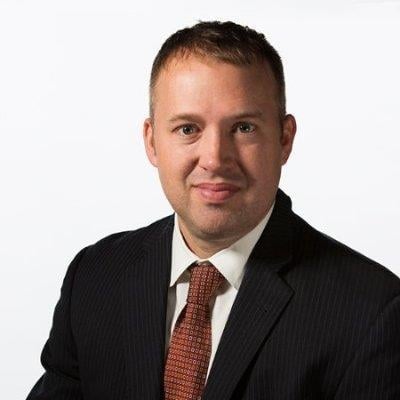Three questions on academic innovation for U-M’s Mike Daniel
As the senior director of policy and chief operating 0fficer at the University of Michigan’s Center for Academic Innovation (CAI), Mike Daniel has a big job. I asked Mike if he’d be willing to share some insights into the work of CAI at U-M and some thoughts about his career trajectory.
Q: Tell us about the Center for Academic Innovation (CAI). What role does the CAI play at your university? Can you give us an elevator-ride length list of the main projects, services and initiates that CAI leads?

A: The Center for Academic Innovation plays a crucial role in fostering and scaling learning innovation at the University of Michigan. We collaborate with faculty partners and academic units on campus and around the world to create equitable, lifelong educational opportunities for students and learners everywhere. I am fortunate to work alongside a wide range of expert staff, work in a great facility and enjoy the support of the provost’s office, which collectively enables the center to lead projects across a number of domains, including:
Online, hybrid and blended learning programs, including for-credit and noncredit offerings. CAI offers learning experience design, media design, learner support, market research and portfolio planning services to create, launch and support learning experiences. In practical terms, we have created over 250 MOOCs which have enrolled over 11 million learners and support several online degree programs at the university.
Educational technology tools and platforms. CAI offers integrated software development, behavioral science and user-experience design services to create educational technology solutions that enhance student success. Our current portfolio of 10 tools is used by almost every undergraduate student in Ann Arbor, and have been adopted by several other institutions.
Educational research and analytics. CAI maintains the university’s online learning data warehouse, and offers educational research and learning analytics services to researchers on campus.
Extended reality learning experiences. In Fall 2023, the center moved into a new facility with a groundbreaking virtual-production studio, catalyzing our ability to develop virtual reality, augmented reality, mixed reality and virtual-production experiences to support learning in residential courses and online learning.
Education and innovation policy. CAI offers policy-development guidance and regulatory-compliance support in service of learning innovation and student success programs and initiatives. We also contribute expertise to campus efforts on digital privacy, vendor licensing and analytics-data governance.
Q: The University of Michigan has over 50,000 students and operates with an over $11 billion budget. For colleges and universities that don’t operate quite on U-M’s scale, what would you say might be the role of an organization such as CAI dedicated to academic innovation? Where do you think that smaller institutions should invest in capabilities around academic innovation?
A: When CAI was first getting started back in 2014 our charge was to create a culture of innovation in learning at the University of Michigan. It is a big charge, but the approach we took could work at an institution of any size. First we focused on identifying a handful of “early adopter” faculty who were passionate about experimenting with online learning modalities and educational technology. Shared goals included increasing access to U-M to global learners and to enhance the learning experience for students on campus here in Ann Arbor. At the time, we partnered with these faculty to undertake projects together and demonstrate the efficacy and impact of various approaches to delivering content and increasing access to the university through these various instructional modalities and technologies.
Other colleges and universities, even those not currently in a position to invest in the creation of a central innovation unit like CAI, may want to look at this model of both seeding some experiments in online and hybrid learning around their institutions and then purposefully and intentionally engaging faculty as champions to scale the success stories across their institutions. One thing we learned early on was to gain momentum at our university, we needed to first “prove” these types of innovations would work in our environment.
Smaller institutions can absolutely benefit from investing in capabilities around academic innovation to stay competitive, meet the evolving needs of learners and differentiate themselves in the higher education landscape. By focusing on academic innovation, smaller institutions can enhance student engagement and improve learning outcomes.
Q: You have a super-impressive educational and professional background. Your law degree is from the University of Michigan and you spent time as an associate and manager at Huron Consulting. What advice do you have for others looking to move into a leadership role at a university from an educational and professional background outside of the traditional Ph.D. and faculty academic route?
A: While I don’t know about the “super impressive” part, I will certainly accept the compliment and thank you for it! I feel very lucky I found my way into working in higher education. After trying my hand as a corporate lawyer at a couple of large firms in Chicago, I was very fortunate to spend several years at Huron with a great group of colleagues learning the business of higher education and the unique aspects of how universities function and make decisions (large and small).
During my time at Huron, I worked on a wide variety of projects for universities nationwide, building a network and increasing my familiarity with how certain key areas, like faculty governance and budgetary decisions, play out at these various institutions.
While I learned a ton during my time in consulting, I came to realize that working directly for a university is where my true passion lies, and I was extremely lucky to be brought on at Michigan by the center’s founding executive director, James DeVaney.
Universities are incredibly complex organizations (as your readers assuredly know already), so if you can show that you appreciate that complexity and are willing to come at challenges with a collaborative and solution-oriented approach, you will be able to find a path in this industry.
We work at mission-driven nonprofit organizations that are both incredibly tradition-rich and constantly changing and evolving. Understanding that and demonstrating that it is a feature, not a bug, of working in higher ed to our faculty colleagues is a great place to start if you are interested in pursuing a leadership role in this industry.
You may be interested

Which Olympics events are Katie Ledecky swimming in? Here’s how and when to watch her next heat
new admin - Jul 27, 2024Katie Ledecky of the United States prepares to compete in the Women's 800m freestyle final on Day Eight of the…

Arson attack disrupts France’s high-speed rail system
new admin - Jul 27, 2024Arson attack disrupts France's high-speed rail system - CBS News Watch CBS News A coordinated arson attack disrupted France's high-speed…

Horoscopes today – Russell Grant's star sign forecast for Saturday, July 27
new admin - Jul 27, 2024TODAY'S horoscope has one star sign enduring slow progress, while another proves inspirational. What else can you expect? Russell Grant…


































